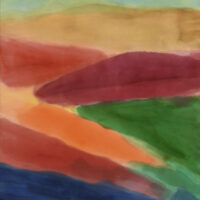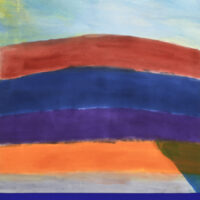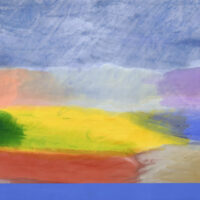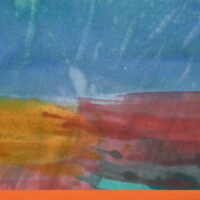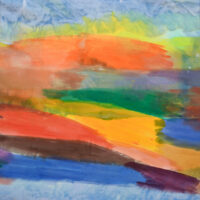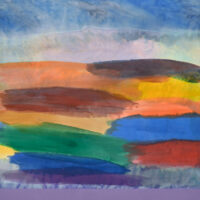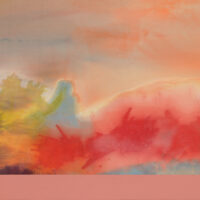Belynda Henry
Dates
Biography
Belynda Henry is among a select group of Australian landscape painters to achieve international success. Her previous U.S. show in New York City was a sellout, and style arbiter and collector Christian Louboutin acquired more than half of the works. “Magnificent landscapes and the reflections on the water are oh so vibrant—sublime colors,” Louboutin related.
Henry first entered the ranks of leading and celebrated landscape painters in this country in 2000 after being a noted finalist in the Wynne Prize. Edmund Capon, the then-director of the Art Gallery of NSW, pointed out her work to Stuart Purves, director of the prestigious Australian Galleries. Purves noted that she brought “simplicity in her work… within a complicated world” and quickly pulled her into his artist stable. She is now a multiple finalist of both the Wynne and Archibald prizes, amongst other prestigious awards, and her work has been exhibited alongside some of Australia’s most prominent and influential Australian artists, including Fred Williams, Arthur Boyd, Jeffrey Smart, Lloyd Rees, Brett Whiteley, John Kelly, William Robinson, Garry Shead, John Wolseley, Inge King, George Baldessin, and John Coburn. She has held more than 30 solo shows over a prolific career. Henry lives and works deep within a long, lush valley along the wild escarpments north of Sydney. She is embedded in the landscape and exposed to its ways, witnessing the transitions of everchanging light, texture and soundscape. All of this she absorbs into her compositions of nature and the infinite fascination of the land. Henry’s works bring forth the internal meditative quality evoked by landscape, illuminating these impressions in wondrous, imaginative works. Her work has been regularly featured in media coverage, including Vogue magazine, and she was considered one of the “seven artists you should invest in now” by The Age.
Henry’s work has been acquired by private collections in the United States, Japan, Switzerland, Taiwan, New Zealand, Ireland, Hong Kong, Athens, Paris and London. Her work appeared in the acclaimed Thames & Hudson tome on Australian art, A Painted Landscape. Amongst those who have praised Henry’s work is fashion icon Akira Isogawa, with the designer describing her painting as “a pure form of the metaphysical landscape which almost crossed over Japanese calligraphy.” Henry’s work “somehow triggered my childhood memory of gardens in Kyoto,” Isogawa wrote. Henry’s previous New York gallerist, Tim Olsen, said, “Her sell-out exhibition in New York with us was a testament to her talent.” Quoted in a newspaper report on Henry’s international rise, Olsen said her work “seduces the eye.” “People who had never seen Australia felt enamored by the ethereal qualities of her work,” he said. “International collectors felt an intimacy and visual experience that extended beyond any axioms of a provincial experience. Her work is universal. Belynda Henry is a rare artist. Her interaction with landscape has a profound aesthetic and construct. She marries her incredible sensibility for the colors of her surrounding bushland with an underlying abstract structure,” Olsen said. In her work, Henry references the deep structure, shifting shapes and pure colors of the landscape through a meditative state rather than a literal one.
After experiencing the landscape during daylight, she returns to her studio with sketches, notes and a mind-space of imagery, allowing the works to form by night. For this series, Henry sequestered herself for an intense period to bring together her rich body of fieldwork. She says of this process that she must let the works “imagine themselves, like a dream sequence,” taking us to the precipice of total abstraction, yet masterfully holding the viewer with spare pieces of evidence caught within the work, keeping a footing in traditional genre and rendering her painting hypnotically relatable.
My work speaks to both the beauty and brutality of our landscape, a landscape that I have lived in my whole life.
Most artists have visited or embedded themselves in the landscape for a while, but I have been fortunate enough to live and paint within it. I have always lived within this unique and seductive landscape; it breathes and shakes with the wind and is in constant regeneration or decay. The sounds of birds – like sonar, bounce around my studio before they dissipate, keeping me on edge. Although I may be embedded in it – I am not entrapped by it. I’m free when I paint, liberated like most are tethered. And I am grateful – to paint is to love.
My landscapes both respond to place and, at times, express a more emotional rather than literal connection. It is my escape – using color and energy, I create calm. Color choice comes naturally and instinctively after painting for over twenty-five years. I have as many colors out and mixed as physically possible on my oversized painter’s table and color choice, and the process after that is automatic – based on a mix of memory and new discoveries. The works can be healing or confronting. I have realized when I go into the mode of painting, when in the moment, it may not be the landscape I am painting, at times, it can be an outpouring of dreams or fears.
Abstract painting comes from the subconscious mind, yet I aim to bring the viewer to the precipice of abstraction by leaving a small natural element in the work that brings the viewer back to more of a traditional landscape. I create these landscapes so I can be in them as well. So I hope someone who appreciates my work doesn’t choose it because they love it, more so because the work loves them back, as that is my intention.
– Belynda Henry
Solo Exhibitions
2024 Harvesting the Valley, Findlay Galleries, Palm Beach, FL, USA
2023 Nocturnal Compositions, Post Space, Exeter, NSW, AUS
2022 To Paint is to Love, Gruin Gallery, Los Angeles, CA, USA
2022 Further Afield, Edwina Corlette, Brisbane, QLD, AUS
2022 Works on Paper, Australian Galleries, Sydney, NSW, AUS
2021 To Paint is to Love, Australian Galleries, Sydney, NSW, AUS
2021 Woollahra Gallery at Redleaf, Double Bay, NSW, AUS
2020 The Space Between, Olsen Gruin, New York, USA
2019 Australian Galleries, Sydney, AUS
2019 Reflections, Flinders Lane Gallery, Melbourne, AUS
2018 Landscape Lines, Australian Galleries, Sydney, AUS
2017 Sydney Contemporary, For Australian Galleries, AUS
2017 The Wanderer, Flinders Lane Gallery, Melbourne, AUS
2017 The Design Files Open House, Melbourne, AUS
2016 Recent Landscape Paintings, Flinders Lane Gallery, Melbourne, AUS
2016 Living Colour, Recent Landscapes, Olsen Gallery, Sydney, AUS
2016 Design Files Collect, Melbourne, AUS
2016 Flinders Lane Gallery, Melbourne, AUS
2015 Higher, Koskela, Sydney, AUS
2014 Overgrown, Design Files Collect, Melbourne, AUS
2014 Jigsaw, Anthea Polson Art, QLD, AUS
2012 New Paintings, Richard Martin Art, Sydney, AUS
2010 Overview, Opened By Lisa Thomas, Vogue Living, Richard Martin Art, Sydney, AUS
2008 The Four Seasons, Richard Martin Art, Sydney, AUS
2007 Shimmer, Greenhill Galleries, Perth, AUS
2007 Shadows Of Nature, Richard Martin Art, Sydney, AUS
2006 Recent Paintings, Libby Edwards Galleries, Brisbane, AUS
2005 Life And Paddocks, Richard Martin Art, Sydney, AUS
2005 New Paintings, Gallery 460, Kincumber
2005 Driving, Libby Edwards Galleries, Sydney, AUS
2004 Still Life Paintings, Libby Edwards Galleries, Melbourne, AUS
2004 New Paintings, Greenhill Galleries, Adelaide, AUS
2004 New Paintings, Greenhill Galleries, Perth, AUS
2003 Libby Edwards Galleries, Sydney, AUS
2002 Libby Edwards Galleries, Melbourne, AUS
2002 Paddock Lines, Greenhill Galleries, Adelaide, AUS
2001 Floating Over Paddocks, Von Bertouchs Galleries, Newcastle, AUS
2001 Light And Paddocks, Avoca Fine Arts Gallery, Avoca, AUS
1999 Love, Light And Paddocks, Avoca Fine Arts Gallery, NSW, AUS
1996 And Anywhere Is, Avoca Fine Arts Gallery, NSW, AUS
1994 Playing In The Secret Garden, Avoca Fine Arts Gallery, NSW, AUS
Awards
2004 Highly Commended, Open Section, Wyong Art Show
2003 First Place, Open Award, Wyong Art Show, Adjudicated By Nick Mitzovich, Director, Newcastle Regional Art Gallery
2002 First Place, Artscrawl, Landscape Award, Pokolbin, Adjudicated By Ken Done
2000 Highly Commended, Sculpture Section, Wyong Festival Of The Arts
Recent Exhibitions
I love a sunburnt country, a land of sweeping plains, of ragged mountain ranges, of drought and flooding rains, I love her far horizons, I love her jewel sea, her beauty and her terror – the wide brown land for me.
– Dorothea Mackellar




















